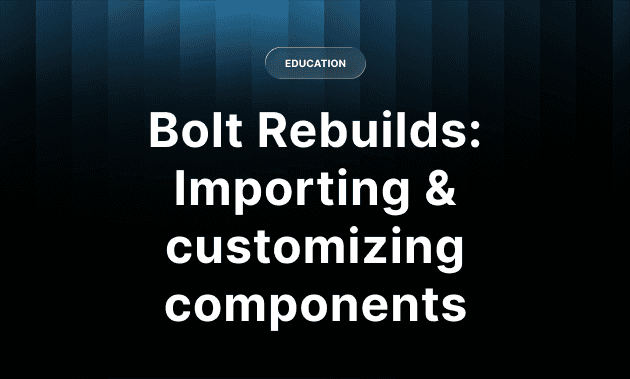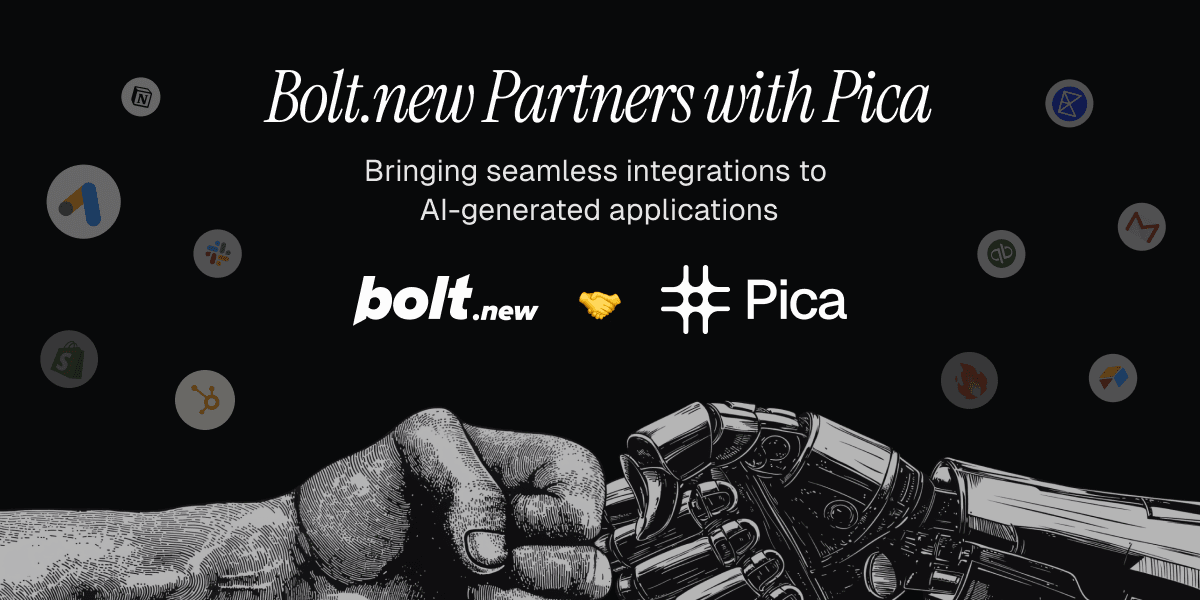Aug 29, 2025
What can you actually build with Bolt? 10 real use cases
See how product teams, freelancers, and solo founders around the world are using Bolt to launch fully functional software and fast prototypes.
Educational
Every week, people surprise us with what they make in Bolt. Enterprise product teams, solopreneur designers, and ambitious first-time builders alike have spun up everything from fully-functional fitness tools to real, revenue-generating AI apps.
The range is mind-blowing. People launch projects we never could’ve imagined until they went live. And if you’re just hearing about Bolt for the first time, it all sounds a bit too good to be true.
So if you’re wondering what “build anything” means practically, we’ve got you covered.
We collated 10 real use cases for vibecoding skeptics looking for specifics on what they can actually create, busy product teams who want to build prototypes without bothering their engineering teams, and everyone in between.
1. Websites

Agencies and freelance designers are paid to bring their client’s brand vision to life via beautifully designed websites. But these projects typically require skills outside their wheelhouse, like writing code, setting up servers, configuring databases, and accounting for all the other details that make a site actually work.
Before, designers without coding experience had to bring in costly engineering teams or outsource development, which slowed their projects down and ate into margins.
With Bolt, the same person who designs the site can also create and publish it. And because you can use Bolt to build a fully functional, customer-ready website yourself in hours instead of weeks, you can ship projects for clients way faster and at way lower cost.
Bolt takes care of the technical foundation automatically, so designers can stay focused on what they do best: delivering stunning experiences for their clients.
See examples in the Bolt gallery: Business websites and landing pages
2. Fast (but functional) prototypes
Enterprise product teams often need to demonstrate how a complex workflow should behave before committing to actually building something real. In cases like these, a Figma mockup just doesn’t cut it.
With Bolt, product teams can create live, functional prototypes in hours. Stakeholders can click through real flows, developers get clearer specs, and feedback happens earlier. That speed lowers the cost of experimentation and helps teams make smarter decisions before developers write a single line of code.
For enterprises, the payoff is huge: faster cycles, fewer surprises, and products that launch closer to the vision.
Agencies and freelancers can also benefit from fast prototyping. Before winning a client, you need to stand out in the pitch. Instead of sharing slides or screenshots, walk a client through a working prototype you built in Bolt. It’s a powerful way to impress clients, win projects, and justify higher-value work.
3. Lead-capturing landing pages

For most businesses, their website is the front door to new customers. Your success hinges on getting that sweet, sweet customer info when someone clicks “Get a Quote” or “Book a Demo.”
With Bolt, small businesses can create landing pages that do more than look good. Forms on the page can feed directly into CRMs through integrations like PicaOS. Every lead, every inquiry, every form submission, etc. doesn’t just end up buried in someone’s inbox.
It goes straight into the system where sales or operations teams can follow up, track progress, and close deals.
The old way usually involves duct-taping plugins, paying for third-party form tools, or hiring developers to wire everything together. Bolt simplifies all that. Business owners get a professional landing page, live lead capture, and automated CRM integration just by chatting with AI.
4. Internal tools for enterprises (CRMs, ops dashboards)

Every company runs on a whole host of software that’s a lot more expensive and convoluted than it needs to be. You likely have a CRM to track customers, an ops dashboards to monitor the business, editors to manage databases and content, and on and on.
The problem is, getting these tools in place usually means one of two things: waiting months for engineering to prioritize them, or paying an arm and a leg for off-the-shelf software that never quite fits.
Traditional CRMs, for example, often come with sky-high seat costs and require a consultant just to configure them. Ops dashboards are either cobbled together with spreadsheets or gated behind expensive SaaS subscriptions.
So just build it yourself with Bolt. Want an operations dashboard to monitor shipments in real time? Spin it up. Need a lightweight CRM that your team can actually understand? No problem. Content moderation queue? Database editor? All possible, and all without waiting on another department’s roadmap or navigating a maze of licensing costs.
See examples in the Bolt gallery: Internal tools for businesses
5. SaaS products

With Bolt, you can launch the essentials of a SaaS app right away: logins, dynamic data, and subscription payments through Stripe. The typical barriers to entry (money and technical skill) just don’t exist.
Instead of waiting on developers or burning through savings, founders the world over are proving out SaaS businesses in days, validating demand, and scaling from there.
Anyone with an idea can set up databases, authentication, hosting, payments, and more without ever leaving the editor.
6. Niche communities, social apps, and chat forums

As a society, our relationship with the top social media giants is complicated to say the least. If you want to build your own insular community or create a social media app that hasn’t been overtaken by ads and addictive UX optimizations, use Bolt to build a digital haven.
With Bolt, you can create highly focused communities in hours.
Because you’re not pouring weeks of time and piles of money into developing these spaces, you don’t have to worry about whether your project has broad appeal. You can create a forum, community, or app as niche or off-beat as you want: a discussion board for local artists, a link-sharing hub for coffee nerds, or a real-time chat app for your friend group.
Use Bolt to enable live chat, post feeds, moderation controls, user accounts, and more.
See examples in the Bolt gallery: Community forums and social apps
7. Web-based games

You could easily be sitting on the next Wordle, 2048, or Flappy Bird. They’re all small, clever, browser-based projects that exploded because they were simple to play and easy to share.
That’s the magic of web-based games: they’re instantly accessible, no downloads required, and they spread fast.
For indie developers and solo creators, the challenge has always been the setup.
Bolt simplifies that part by a lot. With Bolt, you can go from idea to playable game in a fraction of the time. Everything (hosting, deployment, database) comes built in, so creators can focus entirely on mechanics, design, and logic.
See examples in the Bolt gallery: Games and entertainment
8. Mobile apps (without app stores)

Most ideas people have for mobile apps don’t need the overhead of the App Store or Google Play. But until recently, that was the only path. You had to register developer accounts, check off app store guidelines, wait through review processes, and ship updates on someone else’s schedule.
Progressive Web Apps (PWAs) don’t need all that. Basically, they’re web apps that behave like native mobile apps. They can be saved to your home screen, run offline, and deliver the same fluid experience people expect from mobile software.
With Bolt, you can design and launch mobile-first tools in a matter of days.
The advantage is speed to market. Instead of burning weeks (and a bunch of money) getting approval in app stores, you can test your idea with real users immediately.
For solopreneurs and small teams, that means a new category of apps is within reach: mobile experiences that feel native, cost a fraction to build, and land in your users’ hands whenever you’re ready to launch.
See examples in the Bolt gallery: Mobile
9. Interactive Portfolios

If you’re a designer, developer, or any other type of creative, you absolutely need a great portfolio. And in certain creative professions, a static gallery of screenshots just doesn’t cut it.
With Bolt, you can make your portfolio a lot more engaging.
Interactive portfolios are easy to build and publish. Instead of flat images, you can showcase live demos of your projects, clickable flows, or interactive case studies that walk potential employers through your process step by step.
An interactive portfolio gives viewers a more complete sense of the depth of your expertise. Plus, it just looks better.
See examples in the Bolt gallery: Portfolios
10. Custom e-commerce storefronts

Selling stuff online? Use Bolt for your digital storefront, complete with dynamic inventory and secure payments powered by our Stripe integration.
Most e-commerce platforms force you into cookie-cutter templates that look like everyone else’s.
With Bolt, you can do your own thing. You get built-in databases, so you can manage live inventory. You can use our Stripe integration to accept payments securely from day one. And, most importantly, you can build a digital storefront with user flows and customizations that match your brand through and through.
Whether you’re selling handmade goods, running a DTC brand, or experimenting with a digital product, Bolt gives you the speed and flexibility to go live and start selling without compromise.
See examples in the Bolt gallery: e-commerce
Got an idea? Start building with Bolt.











